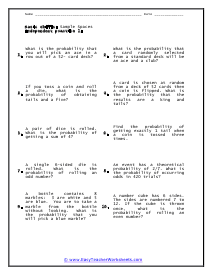In mathematics, sample space is the set of all possible outcomes of an experiment or situation. In mathematics, sample space is the set of all possible outcomes of an experiment or situation. An outcome is a result of an experiment. For instance, if we were flipping a coin, there are only two possible outcomes (sample space) which are heads or tails. If we were to roll a six-sided die, the sample space would be six possible values. Sample space is normally signified by the letter "S", which make sense. You may also see it signified by the use of brackets { }. All of the values that reside within those brackets are the data points we are expecting. Being able to understand all the possibilities of an experiment help us to better understand the odds of achieving those results. As we cruise through all of the work on this page, we will explain how to breakdown a scenario and understand the chance end results.
In these worksheets, students will work with sample spaces. In these worksheets, students will learn how to determine sample spaces. They will find sample spaces for given situations. All problems are presented as word problems, describing a specific situation. This set of worksheets contains step-by-step solutions to sample problems, both simple and more complex problems, a review, and a quiz. It also includes ample worksheets for students to practice independently. Additional paper may be required in order for students to have room for their calculations. Worksheets are provided at both the basic and intermediate skills levels. When finished with this set of worksheets, students will be able to find sample spaces for situations. These worksheets explain how to determine sample spaces. Sample problems are solved and practice problems are provided.

















